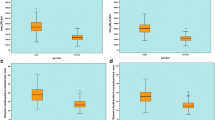Summary
The normal grip strength, pinch strength and key strength was determined by specially designed dynamometers in 30 females and 30 males aged 22–68 years. No significant difference was found between the strength patterns of the dominant and non-dominant hand. It is concluded that in the evaluation of hand strength under pathological conditions, the strength of the other hand should be a useful parameter.
Zusammenfassung
Die Kraft beim Faustgriff, Pinzettengriff und Schlüsselgriff wurde mit spezieller Dynamometer untersucht. Dreißig gesunde Frauen und 30 Männer wurden geprüft. Kein signifikanter Unterschied im Kraftmuster zwischen dominierender und nicht-dominierender Hand wurde gefunden. Wenn man die Stärke einer geschädigten Hand untersucht, dient die gesunde Hand als nützlicher Parameter für den Grad der Schädigung.
Similar content being viewed by others
References
Anderson WF, Cowan NR (1966) Hand grip pressure in older people. Br J Prev Soc Med 20:141–147
Fünfgeld EW (1955) Vigorimeter: Zur Kraftmessung der Hand und zur Simulationsprüfung. Dtsch Med Wschr 91:2214–2216
Heyward V, MC Keown B, Geeseman R (1975) Comparison of Stoelting hand grip dynamometer and linear voltage differential transformer for measuring maximal grip strength. Res Quart 46:262–266
Hunsicker PA, Donnelly RJ (1955) Instruments to measure strength. Res Quart 26:408–420
Kellor M, Frost J, Silberg N, Iversen I, Cummings R (1971) Hand strength and dexterity. Am J Occup Ther 25:77–83
Lee P, Baxter A, Dick WC, Webb J (1974) An assessment of grip strength measurement in rheumatoid arthritis. Scand J Rheum 3:17–23
Mannerfeldt L (1966) Studies on the hand in ulnar nerve paralysis. Acta Orthop Scand [Suppl] 87
Nwuga VC (1975) Grip strength and grip endurance in physical therapy students. Arch Phys Med 56:296–300
Petrofsky JS, Lind AR (1975) Isometric strength, endurance and the blood pressure and heart rate responses during isometric exercise in healthy men and women, with special reference to age and body fat content. Pflügers Arch Res Physiol 360:49–61
Rikli R (1974) Effects of experimenter expectancy set and experimenter sex upon grip strength and hand steadiness scores. Res Quart 45:416–423
Schmidt RT, Toews JV (1970) Grip strength as measured by the Jamar Dynamometer. Arch Phys Med 51:321–327
Swanson AB, Matev IB, de Groot G (1970) The strength of the hand. Bull Prosth Res 145–153
Thorngren KG, Werner CO (1979) Normal grip strength. Acta Orthop Scand 50:255–259
Author information
Authors and Affiliations
Rights and permissions
About this article
Cite this article
Reikerås, O. Bilateral differences of normal hand strength. Arch. Orth. Traum. Surg. 101, 223–224 (1983). https://doi.org/10.1007/BF00436775
Received:
Issue Date:
DOI: https://doi.org/10.1007/BF00436775




